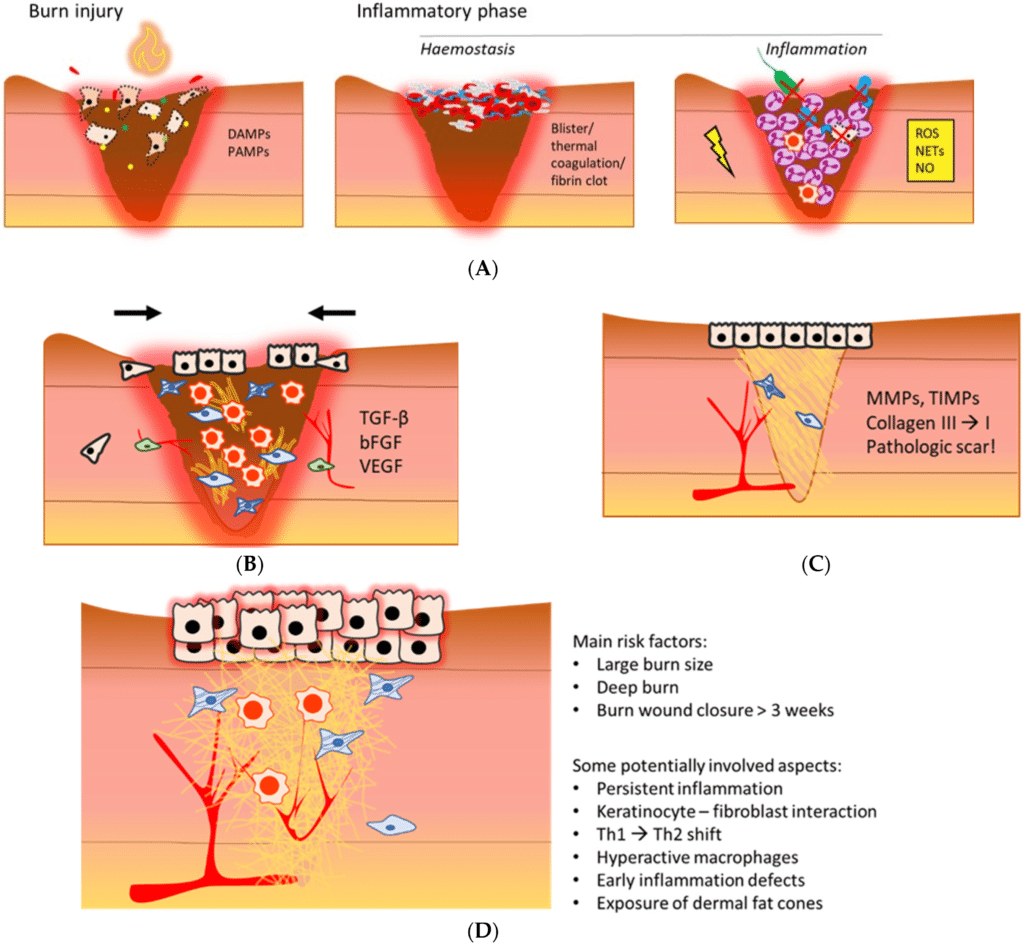Post-burn conditions refer to the physical and psychological sequelae that may occur following a burn injury. Burn injuries can result in a wide range of complications, including both immediate and long-term effects, depending on the severity and extent of the burn, as well as the effectiveness of treatment and rehabilitation.
Some common post-burn conditions include:
- Scarring and contractures: Severe burns can lead to the formation of scar tissue, which may cause cosmetic deformities, functional impairments, and contractures (tightening of the skin and underlying tissues), restricting movement and flexibility. Scar management techniques such as pressure garments, massage therapy, and surgical interventions may be used to improve scar appearance and mobility.
- Pain and hypersensitivity: Burn injuries can cause persistent pain, hypersensitivity, and neuropathic symptoms in the affected area, known as post-burn neuropathic pain (PBNP). Pain management strategies may include medications, nerve blocks, physical therapy, and psychological interventions to help individuals cope with chronic pain and discomfort.
- Reduced mobility and function: Severe burns involving joints, muscles, or tendons can result in reduced mobility, stiffness, and functional limitations, impacting activities of daily living and quality of life. Physical therapy and occupational therapy are essential components of rehabilitation to improve strength, range of motion, and functional independence following burn injuries.
- Psychological and emotional trauma: Burn injuries can have profound psychological and emotional effects on individuals, including anxiety, depression, post-traumatic stress disorder (PTSD), and body image disturbances. Psychosocial support, counseling, and mental health interventions are crucial for addressing the emotional impact of burn injuries and promoting psychological well-being.
- Respiratory complications: Inhalation injuries resulting from exposure to smoke, steam, or hot gases during a fire can cause damage to the airways and lungs, leading to respiratory complications such as pneumonia, acute respiratory distress syndrome (ARDS), and chronic obstructive pulmonary disease (COPD). Respiratory support, oxygen therapy, and pulmonary rehabilitation may be necessary to manage respiratory complications and optimize lung function.
- Nutritional deficiencies: Severe burns increase the body’s metabolic demands and can lead to malnutrition, weight loss, and deficiencies in essential nutrients such as protein, vitamins, and minerals. Nutritional support, including enteral or parenteral nutrition, may be required to meet the increased caloric and protein needs of individuals recovering from burn injuries and promote tissue healing and recovery.
- Long-term complications: Some individuals may experience long-term complications following burn injuries, such as chronic pain, joint stiffness, recurrent infections, and delayed wound healing. Long-term medical follow-up and multidisciplinary care are essential for monitoring and managing ongoing health issues and preventing complications.
Overall, comprehensive care and rehabilitation are essential for individuals recovering from burn injuries to address both the physical and psychological consequences of their injuries and optimize their long-term outcomes and quality of life. Multidisciplinary teams consisting of burn surgeons, nurses, physical therapists, occupational therapists, psychologists, and social workers work collaboratively to provide holistic care and support for individuals affected by burn injuries.









